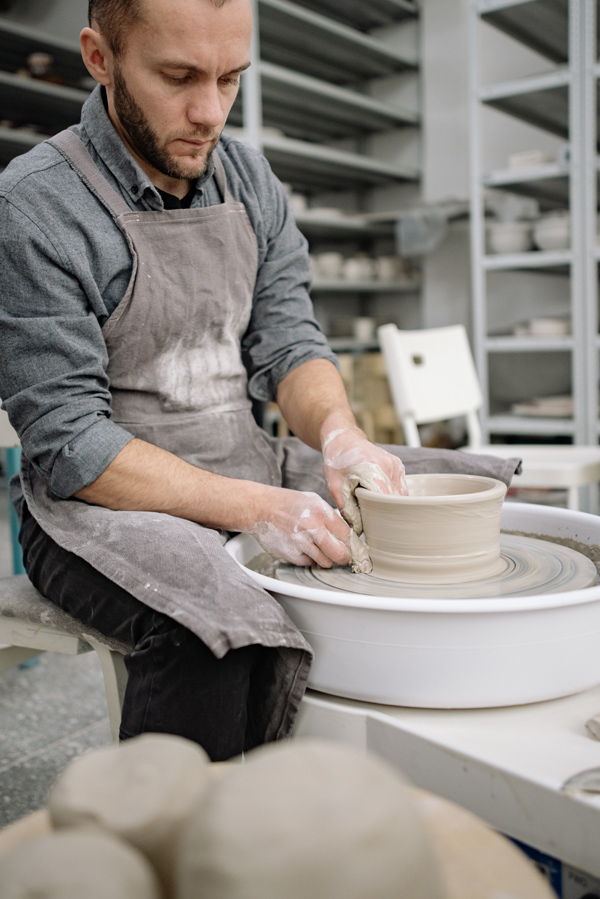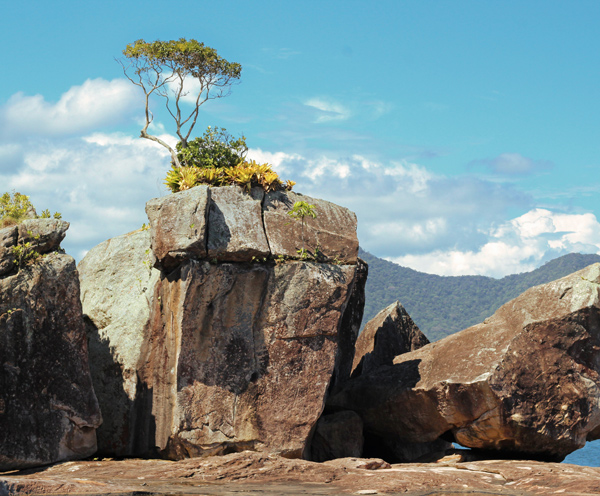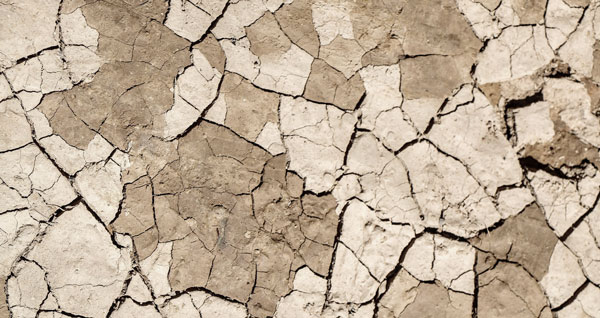Brian wonders about gardening in clay:
I would like to take steps in this direction but feel stuck. My growing space consists entirely of horrible, horrible Piedmont clay. I’ve built raised beds (layered with lots of organic stuff, partly out of necessity and partly to improve the soil. But to my horror, I was moving soil recently and discovered that not only had the soil at the bottom of a bed had not improved, but the red clay monster had seemed to grow and consume some of the soil I had brought in to use. There was MORE mud than before I built the beds. Drainage is an absolute disaster.
Is a food forest hopeless in this scenario? The concept of planting in-ground seems impossible here. I also have a gently sloping space and was wondering if that should affect my attempts.
He left that comment on my brother-in-law Justin’s recent post on his Grocery Row Garden in Delaware.
That really is a difficult situation. Clay suffocates plants by preventing drainage and drowning their roots. It’s also quite hard to work, and working it makes it even harder.

My initial response to his comment was just eight words: Are there trees that grow in your area?
That’s unnecessarily wordy, though: I could have just written
Got Trees?
Forests grow in sand and in clay and everywhere in between. They’ll even grow out of rock, if given half a chance:

The trick is to get them started.
As recommended by Piedmont Master Gardeners:
Modifying clay soils for vegetable gardens or flower beds is one thing. Tree and landscape planting however is more a matter of choosing plants that can do well in the native soil and planting them in a way that makes success most probable.
The recommended way to plant a tree or shrub is a bit different for clay than for well-drained, looser soils:
- Prepare the plant. Remove it from its container and if, as is likely, its roots are curling around the root ball, cut the roots with a knife, from top to bottom of the root ball, every 4-6 inches. This releases the roots to grow out from the plant and prevents girdling problems after planting.
- Dig the hole just large and deep enough to fit the root ball. Use the existing natural soil for backfill, without amendment. Having a consistent soil type will help the plant adapt and prevent the hole from becoming a water pool that is unable to drain into the surrounding clay.
- Elevate the top of the root ball about 2 inches above the soil line. The water needs to drain away from the plant, again to minimize pooling issues and prevent root rot.
Another thing I recommend is just growing trees from seed wherever you can. They’ll develop very strong root systems right from the beginning and their root activity and exudates improve the clay around them. Bonus points if you plant nitrogen-fixing pioneer trees – you know, the seedy trees everyone hates! – which can then be repeatedly chopped and dropped to add organic matter to the soil surface.
Most soils grow some trees. If you can’t get them growing in your yard, look around and see how nature is doing it. Chances are, she’s throwing tons of seeds around and letting the winners survive.
What About Annuals in Clay?
I have a feeling the raised beds “grew” the clay via watering from the rain and the gardener washing down the clay from the top layers and aggregating all the particles together lower down. Drainage really is a terrible issue in clay. Sometimes the only thing you can do is grow “up” and make mounds to plant upon. We did that in the sticky clay of Grenada. There was a spot we gardened that was hard as a rock when it was dry and as sticky as glue when it was wet. The papaya trees we planted in the dry season rotted and drowned in the ground when they were a few feet tall and the summer rains started falling.
It was terrible. I feel your pain.
The best luck we had was with lasagna gardening – and with the yams we grew in raised mounds of clay.
Lasagna gardening:
That video was filmed on that patch of hard-to-work, sticky black clay.
I would keep layering that organic material, and also think about installing a French drain if possible, as well as trying adding gypsum to loosen the soil.
It’s not an easy task, but I do believe the more plants and organic matter you get growing, the better the soil will become over time. Just don’t till it!
I have a livestream here where we share more:


15 comments
Gypsum worked amazingly in my clay soil. I was able to grow decent-sized potatoes in soil that had been too hard for me to get a shovel into prior to the gypsum. Now after 3 months living with this plot, it’s easy to tell where the gypsum was applied heavier than other places. Bonus, it adds calcium!
Do I just throw the gypsum on top of the grass, or do I need to kill the grass and then add gypsum?
I would just throw it on top. It’s going to leach into the soil just fine.
Gypsum and planting trees and shrubs a little higher than soil level and the simplest solutions. We have sandy loam that, due to magnesium excess, acts like clay with poor drainage. Add in a high water table. Gypsum really helps it act like the loam it is by correcting the calcium-magnesium balance (soil chemistry stuff – see Steve Solomon’s “The Intelligent Gardener”). And it’s like $8 for 40lbs (don’t buy the little 2lb bags!) so depending on how big a space you want to cover, not all that expensive. It’s not a permanent fix – you do have to keep adding it, but all you do is throw it around and let rain soak it in. Plants like the extra calcium and sulfur as well. Good luck and don’t give up! Something will grow there. Worst case, a lot of annuals can be grown in containers while you figure things out and certain varieties of annuals do better in clay than others (like shorter varieties of carrots [Oxheart, Danver’s Half Long] will do better than the 12 inch long kinds).
I have been thinking I might try some gypsum and/or non-dolomitic lime based on the… fairly high likelihood that the local clay needs a calcium-magnesium adjustment, although I should get a soil test done too.
I did build a small hill with sand, pebbles, and compost for rosemary. I think the hill may have flattened out by now but the plants seem to be okay anyway.
As others have said, gypsum is a huge advantage when it comes to softening and loosening the clay soils. I also add a top layer of compost when I apply gypsum to help get more organic matter mixed in while the gypsum has the clay workable.
Another thing I have done is build compost piles in multiple areas or relocate old ones. The soil is always better where a previous pile was located. I like to plant trees in those areas.
Growing good soil is a long term process.
I can only grow annuals in raised beds of excellent soil, similar to Mel Bartholomew’s Square Foot Gardening. The clay here is too hard to make a fine seedbed.
But that heavy clay happily grows strawberries, raspberries, apple trees, and sunchokes.
My suggestion to Brian is to get some perennial fruits in the ground (not from seed), and create some raised beds between them for growing annuals.
Expect to have to add a lot of organic material to the raised beds every year. Don’t expect the clay under the raised bed topsoil to improve; mine didn’t. Treat it as subsoil and add more compost, peat, vermiculite, etc.bon top to keep a deep enough good soil for growing vegetables.
We live in a Hickory/Oak forest. Our soil has more rocks than dirt. Yes, dirt. It is the dead, lifeless, worn out soil of the Ozarks. About a foot down you get past the rocks to clay. It takes a tractor with a post hole digger to plant trees. The only way to garden is with raised beds because of the rocks. No matter how much compost and organic matter you apply it doesn’t effect rocks! They make for good drainage though. I didn’t know I’d be getting into survival gardening when I moved here or I would have gone elsewhere. Hind sight, you know.
This’s another Sandra in Central Texas with the same type of problem, lots of rocks and very little soil which happens to be clay. Please let me know of any tips to garden in this kind of scenario. I love gardening and don’t want to give it up.
In NC I had Holly plants that thrived in clay but I found chicken pens for a year left behind some nice soil. Dumping out worm bins with bird seed and scratch grains had the chickens scratching deep into the clay trying to find grain nuggets and what ever insects living in the bins. Leghorns were the best if your pen has eight feet of bird netting since they are great flyers. All the great scratching birds seem to be great flyers. But if hungry enough they will dig to China.
Why did you say to not till? I live in Alachua and there’s quite a bit of clay. So much, that I couldn’t even dig a hole with a spade big enough to plant trees. I was planning on tilling up some areas and mixing in organic material, is this a bad idea?
Unless you have a lot of organic matter to till in, tilling clay tears up the gaps that are already in it from roots, worms, etc. Then, when it rains on that tilled ground, it becomes even harder – like brick – in the sun.
We have grown amazing garlic in our heavy clay soil in Washington State. And I have always wondered if the clay just has such good minerals. On clay, I wonder about a raised bed that begins with a deep layer of hugelkultur–many many logs, packed close.
I have two hugelkultur beds I am about to move because they have sub-optimal sunlight….I will have to see if the soil there improved.
Thank you brother!! I was beginning to think lasagna/Back to Eden might be the ticket, and hope that bringing in tons of wood mulch and different organic stuff perks everything up. I just panicked a bit when I saw how the raised beds seemed to be making soil quality worse. Yes- trees grow abundantly here in the region, so maybe interspersing the growing area with dwarf trees could really help. Still very much a beginner so this has been a daunting way to start my gardening career!
Comments are closed.